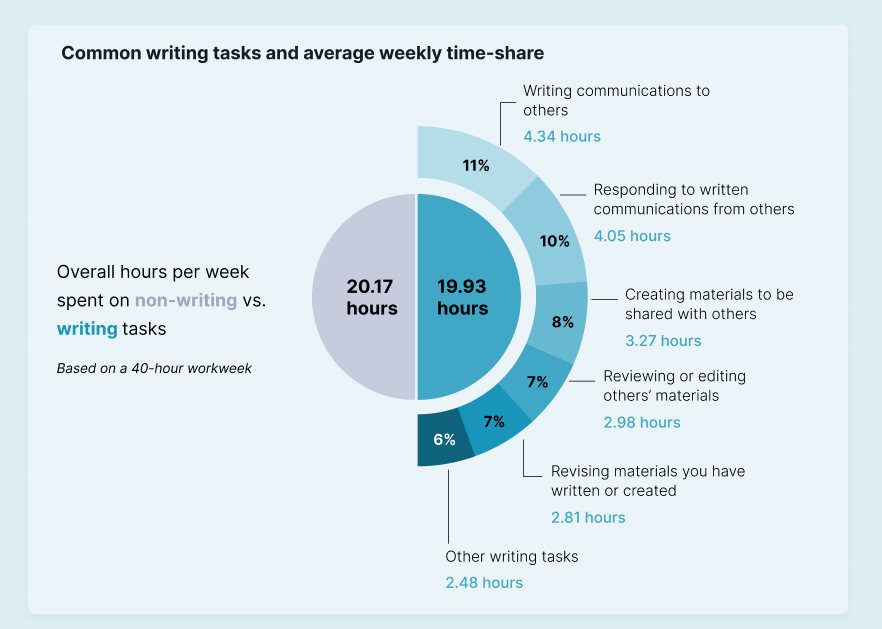Today, the stakes of good business operations are high: A global pandemic has pushed us into a digital work landscape, and the Great Resignation threatens to leave many businesses under-resourced across experience levels. As a result, leaders don’t get a break from thinking about the costs of operating a business.
But did you know each member of your team is spending more than half their workweek doing one kind of activity? And if you could optimize this activity, you could help every employee regain a full business day each week.
That’s exactly what our latest research with the Harris Poll uncovered. We surveyed 1,001 knowledge workers who estimate they spend approximately twenty hours a week on written communication—half of the standard workweek. But communicating effectively is a pervasive business challenge. The 251 business leaders who took part in this study estimate their teams lose nearly an entire working day to poor communication each week.
All told, we estimate ineffective communication is costing businesses in the U.S. as much as $1.2 trillion per year in wasted labor hours — and now business leaders have the data to prove it.
Download Now: The State of Business Communication
See why 93% of leaders agree communication is the backbone of their business
The four-day workweek no one wanted
Every team communicates as part of the job, sending memos and conducting meetings to move projects forward. But as companies move toward business models that are partially or fully remote, the nature of collaboration has shifted from in-person conversations to writing and reading asynchronous messages. Overall, surveyed knowledge workers spend about 24.52 hours per week communicating, with 19.93 of those hours communicating in writing. (By contrast, business leaders spend thirty-six hours per week communicating.)

For all the time we spend communicating, though, it’s doesn’t always go so smoothly. Nearly three in four business leaders agree that “my team has struggled with communicating effectively over the last year,” and that “my company underestimates the cost of poor communication” (72% and 74% of respondents, respectively). Communication difficulties are so pervasive, in fact, that business leaders estimate their teams lose 7.47 hours per week due to poor communication. From this, it’s clear that the five-day workweek is effectively an unofficial four-day workweek, but with none of the productivity and relaxation and all of the stress and burnout of constant digital presence.
Businesses that invest in helping their teams communicate effectively will clean up processes and remove friction from the entire organization. But more vitally, such an investment will allow their teams to make the most of their time and effort today.
The hefty costs associated with ineffective communication
In the study, 96% of business leaders agree that “effective communication is essential for delivering the business results expected of my team in the coming year,” But nearly nine in ten business leaders have experienced an adverse impact of poor communication at work.
For the average full-time knowledge worker on their team, who makes an estimated salary of $66,976, the wasted 7.47 hours each week amounts to a sunk cost of $12,506 per employee per year. You only have to multiply that by the number of employees in your company to appreciate the damage.
This adverse impact takes the shape of direct costs, too, in the form of lost business and lost growth. Among business leaders who reported that they lost business due to poor communication last year:
- 86% value the business lost to be $10,000 or higher
- 60% value the business lost to be $20,000 or higher
- 22% value the business lost to be $50,000 or higher
Companies that stop to assess their business communication now will have a chance to identify common issues, put tools and processes in place to correct them, and recapture lost business and growth.
Assessing the true impact of communication today
Correcting the immediate costs outlined above will have a huge impact on your team’s performance and ability to collaborate. But just as important are the indirect advantages you will gain—advantages that are critical in today’s digital workplace and will improve your teams’ engagement, effectiveness, and everyday experience:
More effective communication builds a culture of engagement and loyalty
Business leaders consistently underestimate just how much time employees spend communicating and collaborating with each other. Business leaders believe their teams spent only 29% of their time collaborating, while knowledge workers report they spent half of their time (49%) working with others. Improving how employees connect and collaborate with their peers will have a measurable impact on employee experience. With record numbers of Americans quitting their jobs, many companies have a new urgency behind retaining employees and encouraging greater engagement.
Greater confidence leads to greater perceived communication effectiveness
Individual confidence in written communication has an amplifying effect when it comes to working together. Knowledge workers who are confident in their own written communication skills are more than six times more likely to perceive the written communication they receive from others as effective.
But there are opportunities to improve: Perceptions of communicating confidently and receiving effective messaging are uneven across relationship levels. Knowledge workers in this study rated themselves as very confident in their communications with their direct managers (75%), team (71%), and other teams (67%). But that level of confidence starts to waver when it comes to third parties and executive leaders—to the extent that knowledge workers are more confident in their communications with professionals outside the organization (60%) than they are with senior leaders within the company (55%).
More effective communication removes on-the-job stressors
Almost half of knowledge workers in our study experience miscommunication at least daily or more, and increased stress at work is the single most common impact of poor communication among knowledge workers. It makes sense—when employees are spending half their day in written communications, it can lead to a lot of long-term frustration.
Investing in your team’s communication skills will bring greater ease, connection, and traction to how they spend so much of the workweek.
Building a communication engine to achieve your full potential
As new challenges apply pressure to your team’s old habits of communication and collaboration, it’s time to become more observant about workplace communication practices, fill in collaboration gaps, and ensure effective communication takes place at every level of operation.
Awareness of how your team operates is critical for business leaders; your company’s success in a more fragmented, remote, and digital workplace relies on a culture of communication that builds bridges. More than ever, communication is the backbone that can make or break the performance of your organization.
Learn more
Get these insights and more when you download the full report: The 2022 State of Business Communication.
To learn how Grammarly Business can help teams manage communication breakdowns and improve individual communication skills across your organization, visit www.grammarly.com/business or get started with Grammarly Business today.




